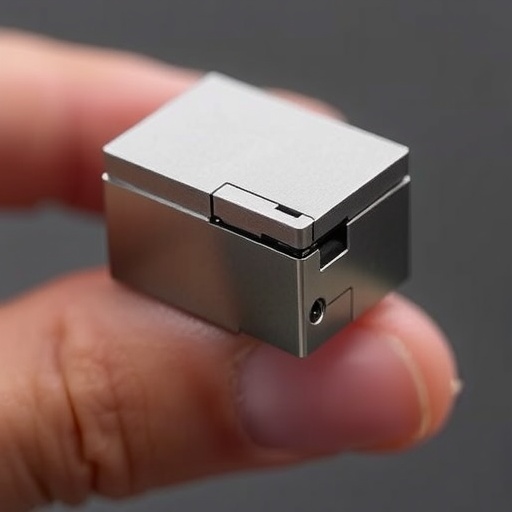In the pursuit of advanced healthcare technologies, the development of non-enzymatic glucose sensors has emerged as a crucial domain in medical diagnostics. Recent research conducted by a team of scientists, including Deng, Zhou, and Zhao, showcases a significant breakthrough in this field through the use of nickel-cobalt-zinc composite materials. The implications of this research extend beyond basic medical applications; they herald a new era in glucose detection technologies that are critical for managing diabetes and related conditions.
The method employed in this research is a novel hydrothermal-molten salt synthesis technique. This approach synergistically combines the advantages of hydrothermal and molten salt synthesis methods, resulting in materials with superior electrochemical properties. The researchers have reported that this composite material not only improves the conductivity but also enhances the stability and sensitivity of glucose sensors, positioning it as a frontrunner in the next generation of diagnostic tools.
One of the notable advantages of this non-enzymatic sensor is its ability to provide rapid glucose detection, which is paramount for diabetes patients who require timely information regarding their blood sugar levels. Conventional glucose sensors often rely on enzymatic reactions, which can be sluggish and less reliable due to the nature of enzymes being susceptible to temperature and pH changes. The novel sensor developed in this study eliminates this bottleneck, allowing patients to monitor their glucose levels more effectively and efficiently.
In addition to sensitivity and response time, the durability of the sensor is a major highlight of this research. Unlike traditional sensors that tend to degrade over time due to enzymatic activity, the nickel-cobalt-zinc composite displays remarkable resistance to various environmental factors. This property is crucial for ensuring consistent performance over longer periods, thereby reducing the frequency of sensor replacements needed by users.
The researchers utilized advanced characterization techniques to validate the electrochemical performance of their sensor. These techniques include cyclic voltammetry and amperometry, which elucidate the sensor’s ability to detect glucose across a wide concentration range. The reproducibility of the sensor’s performance was also tested, steering away from uncertainties that often plague newer technologies and enhancing the reliability of the device for everyday users.
Furthermore, this innovation is not limited to glucose sensors alone. The fundamental principles applied in the development of this nickel-cobalt-zinc composite could pave the way for the creation of sensors for other biomolecules, hence broadening the horizon of non-enzymatic detection technologies. This versatility underscores the significant contributions this research can make within the realm of biosensors.
Another critical aspect of this research lies in addressing the limitations of selectivity and interference that traditional glucose sensors often face. The novel sensor demonstrates an impressive capability to specifically target glucose molecules while minimizing interference from other common biological substances. This selectivity is vital for ensuring accurate glucose readings, especially in complex biological matrices such as blood, where various analytes compete for attention.
To support the feasibility of integrating this sensor into real-world applications, the researchers also laid down some ideas for potential consumer use. They envision that this technology could be embedded in wearable devices, offering convenient and immediate access to glucose levels for users, thus further personalizing diabetes management. Such innovation aligns with the growing trend of digital health platforms that empower patients with real-time data.
Additionally, the environmental impact of producing such sensors cannot be overlooked. The materials used are not only cost-effective but also abundant, thereby posing a lesser risk to the environment compared to other synthetic materials. This aligns with global efforts to enhance sustainability in medical technology and can significantly influence the future design of medical devices.
As the study progresses toward potential commercial applications, the research team is also exploring methodologies to scale up the production of the nickel-cobalt-zinc composites. Mass production is essential to meet the anticipated demand for these innovative sensors and to ensure accessibility for patients who rely on such technology for their daily health management.
The collaboration among the researchers, showcasing a diverse range of expertise, illustrates how interdisciplinary approaches can drive innovation in healthcare technology. The combination of material science, chemistry, and engineering has resulted in a product that not only addresses existing gaps in diabetes management tools but also pushes the boundaries of what is possible in the realm of biosensing technologies.
In conclusion, the development of a non-enzymatic glucose sensor utilizing nickel-cobalt-zinc composite materials marks a pivotal step forward in diabetes diagnostics. As this research transitions from laboratory success to real-world applicability, it has the potential to transform the landscape of personal healthcare while offering hope to millions who struggle with managing their glucose levels effectively.
Subject of Research: Non-enzymatic glucose sensors using nickel-cobalt-zinc composite materials.
Article Title: Development of a non-enzymatic glucose sensor with nickel–cobalt-zinc composite prepared via hydrothermal-molten salt synthesis.
Article References: Deng, T., Zhou, L., Zhao, S. et al. Development of a non-enzymatic glucose sensor with nickel–cobalt-zinc composite prepared via hydrothermal-molten salt synthesis. Ionics (2025). https://doi.org/10.1007/s11581-025-06783-3
Image Credits: AI Generated
DOI: 10.1007/s11581-025-06783-3
Keywords: Non-enzymatic glucose sensor, nickel-cobalt-zinc composite, hydrothermal synthesis, molten salt synthesis, diabetes management, biosensors.
Tags: advanced healthcare technologiesdiabetes management toolsdiabetes-related healthcare innovationselectrochemical properties of sensorsenhanced sensor stability and sensitivityglucose detection technologieshydrothermal-molten salt synthesismedical diagnostics advancementsnext generation diagnostic toolsnickel-cobalt-zinc composite materialsnon-enzymatic glucose sensorsrapid glucose detection methods





